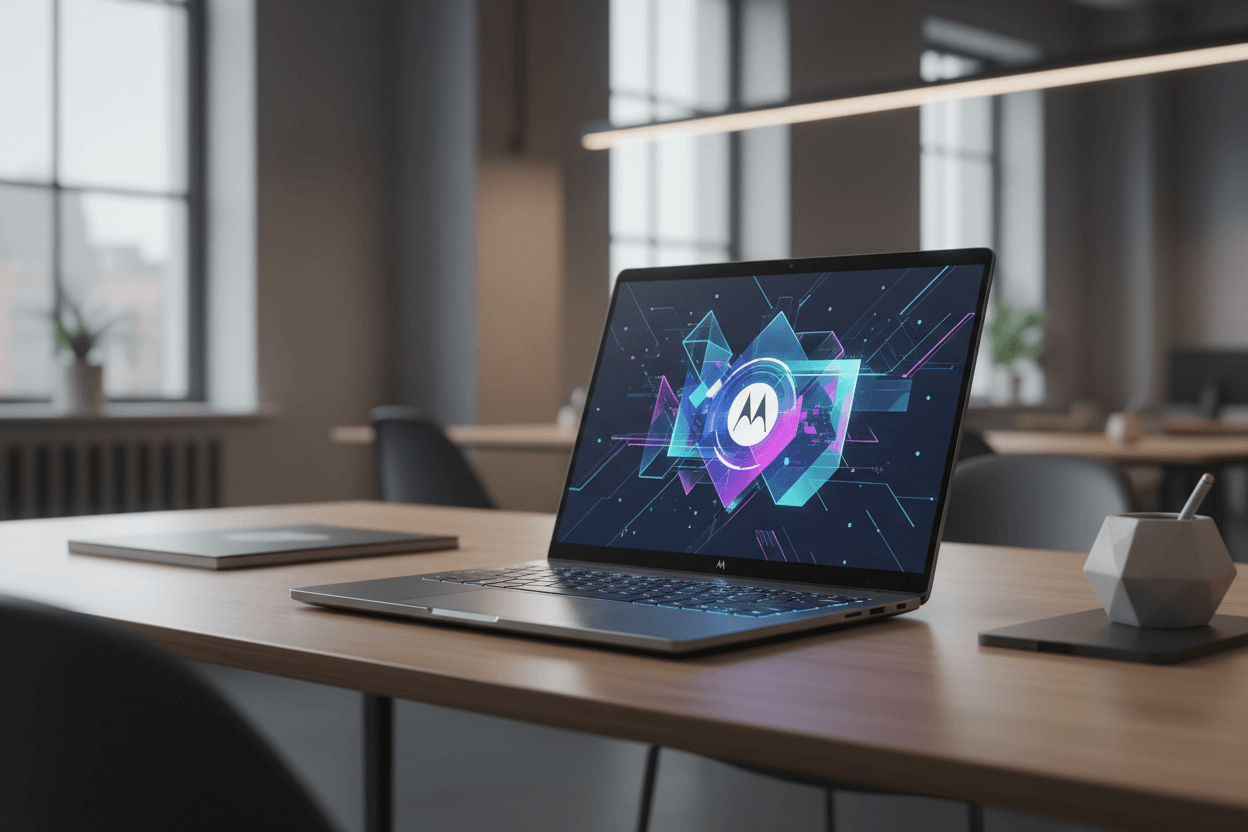Motorola laptops bring innovation to personal computing

Introduction of Motorola laptops
In the Indian laptop market, where many brands compete on price or specs, Motorola’s entrance with the Moto Book series marks a notable shift. With the Moto Book 60 and Moto Book 60 Pro, Motorola is pushing the boundaries of innovation in personal computing, blending high-end hardware, premium design, and smart ecosystem integrations. In this blog, we’ll explore how these laptops bring fresh energy to the Windows laptop space in India — from design and display to performance, connectivity, and the broader computing experience.
Premium Design & Display That Stand Out
One of the first things you notice about the Motorola Moto Book series is its premium build and visual appeal. The Moto Book 60 features a sleek all-metal chassis at about 1.39 kg, which is impressively lightweight for its class. The display choices are equally impressive: a 14-inch 2.8K OLED panel with 120 Hz refresh rate, up to 500 nits+ brightness, and wide colour gamut coverage.
What this means: users in India who want a laptop that feels premium and looks great get more than just the usual matte grey finish. Colour options like Bronze Green and Wedgewood add flair. The high-resolution OLED display delivers sharp visuals and smooth motion — ideal for creative work, media consumption, and everyday productivity. It signals that Motorola is thinking beyond just “good specs for the price”—they’re targeting user experience.
Performance & Smart Ecosystem Integration
Under the hood, both models pack impressive hardware. The Moto Book 60 comes with up to Intel Core 7 240H / Core 5 210H processors, 16 GB DDR5 RAM (upgradeable to 32 GB), and SSD storage (up to 1 TB) in India. The Pro model steps up with Intel Core Ultra 5/7 H-series processors, DDR5 RAM, and built-in AI and ecosystem features.
One of the standout features is Smart Connect: it allows seamless integration between the laptop, smartphone, tablet, and other devices—swipe-to-stream, cross-control, file sharing, etc. For Indian users who already invest in multiple devices (phone, tablet, laptop), this integrated approach adds value beyond raw specs.
In practical terms, whether you’re working on spreadsheets, editing photos, or streaming content, the Moto Book’s hardware and software combination holds up. The use of updated processors and modern connectivity (Wi-Fi 7, USB-C with Power Delivery and DisplayPort) ensures future-readiness.
Versatile Connectivity & Practical Features
Motorola’s laptops don’t compromise on ports or connectivity. The Moto Book line offers multiple USB-C ports with data, power delivery and display support, USB-A ports, HDMI, microSD card reader, 3.5mm audio jack, Wi-Fi 7 and Bluetooth 5.4. In a market where ultrabooks often cut ports to save weight or cost, this full-featured approach is appreciated by users in India who still rely on SD cards, external monitors, wired devices, etc.
Durability is another plus: the Moto Book 60 Pro is built to MIL-STD-810H standards, which means better endurance for travel, commuting and everyday wear-and-tear. The fact that Motorola paired style with substance (premium build + durable spec) shows their intent: they’re not just producing budget machines—they’re producing meaningful choices in the “premium-light” segment.
Battery, Thermal & Real-World Usability
No laptop review would be complete without talking about battery life, thermal behavior, portability, and how it all translates in day-to-day use in India. The Moto Book 60 is rated with a 60 Wh battery and supports 65 W fast charging. Given the hardware inside (high-refresh OLED, H-series processors), real-world usage will depend on usage patterns—moderate productivity and streaming use should get you through a typical workday.
Thermals are managed reasonably well according to early reports, although heavy sustained workloads (like long high-res video editing) could push things. The lightweight build (1.39 kg) remains an advantage for students, professionals, and users who carry their laptop to cafés, co-working spaces, or on commute.
What this means: Motorola is offering a laptop experience in India that balances performance, portability and usability—and that’s exactly what many users want when upgrading from older devices or switching brand.
Innovation Through Ecosystem & Brand Strategy
What makes Motorola’s entry interesting is the brand positioning and ecosystem strategy. Traditionally known for smartphones, Motorola’s expansion into laptops signals a broader “lifestyle tech” ambition. They are combining design (Pantone colours), connectivity (Smart Connect), ecosystem integration (phone-to-laptop workflows) in a way that few competitors in the Indian market emphasise.
Their timing is good: as remote/hybrid work becomes more common in India, users want devices that look good, perform well and feel future-ready—not just another budget-fix. Motorola’s laptops bring fresh energy into a category often dominated by grey boxes and generic design.
Furthermore, the price points—starting from about ₹66,990 for the Moto Book 60 in India for the base variant. For a laptop with OLED 2.8K display, 16 GB RAM, metal build, that’s a competitive entry in the premium-light space.
Challenges & Considerations
Of course, no product is perfect—and potential buyers in India should be aware of a few things:
-
After-sales support and service: Since this is a new product category for Motorola (at least in India), service reach, spare-parts availability and support ecosystem may take time to mature. Some users on forums express concerns.
-
Battery life is still constrained by the high-end hardware and display—ultra-long battery is not the primary focus here.
-
The laptop market in India is competitive: brands like HP, Dell, Lenovo, Asus etc have strong presence—Motorola has to prove consistency, software updates, and durability.
-
Upgradeability: While some models support RAM/SSD expansion, users should check specs carefully if that matters to their workflow.
Why This Matters for Indian Users
For Indian buyers, the Motorola Moto Book series brings a few key benefits:
-
Premium experience at competitive price: For users wanting a laptop that looks and feels premium (metal build, OLED display, colorful finishes) without paying flagship notebook prices.
-
Modern hardware and future readiness: With 14-inch 2.8K OLED, 120Hz refresh, latest Intel H-series/Ultra-series processors, Wi-Fi 7 – it reads not only for today but for next few years of use.
-
Ecosystem convenience: If you already have a Motorola (or Lenovo) phone/tablet, the Smart Connect features offer a smoother workflow (sharing files, controlling devices) which increases productivity.
-
Design & portability: At 1.39 kg, these laptops are genuinely mobile—very useful for Indian urban professionals, students, freelancers who move between workspaces.
-
Brand diversification: Seeing more choices in laptop space is healthy for Indian consumers—it drives innovation, pushes other brands to up their game, and gives end-users more options.
Final Verdict
In conclusion, the Motorola Moto Book series (Moto Book 60 and Moto Book 60 Pro) represent a meaningful and welcome innovation in the Indian laptop market. They combine premium design, modern hardware, thoughtful connectivity and ecosystem features in a package that competes admirably in the “premium-light” laptop segment. While there are caveats—especially around service support and real-world battery life—the overall proposition is strong for users looking for a modern, stylish, capable laptop.
If you’re in India and are upgrading your laptop for productivity, creativity, streaming or mobility—considering the Moto Book series makes a lot of sense. It shows that Motorola is serious about personal computing, not just smartphones, and that innovation is increasingly becoming about holistic experience, not just spec-sheet skirmishes.
FAQs
Q.1. What is the starting price of the Moto Book 60 in India?
The Moto Book 60 in India launches at around ₹66,990(approx.) for the 16 GB + 512 GB variant.
With the Pro model, pricing starts from ₹64,990(approx.) for the Intel Core Ultra 5 variant.
Q.2. What kind of display and refresh rate does the Moto Book series offer?
Both Moto Book 60 and Pro models feature a 14-inch OLED display with 2.8K resolution (2880×1800) and a 120 Hz refresh rate.
Q3. Can the RAM and storage be upgraded on these laptops?
Yes — the Moto Book line supports DDR5 RAM (some variants come with 16 GB, upgradable to 32 GB) and SSD storage (512 GB or 1 TB). The Moto Book 60 also offers additional PCIe slots and microSD slot for storage expansion.
Q.4. What ecosystem features does Motorola include to enhance productivity?
Motorola includes Smart Connect features such as cross-device control, swipe-to-stream, file sharing between your phone/tablet and laptop. These help integrate your workflow if you use multiple devices.
Q.5. Are there any concerns or limitations buyers should note?
While the hardware and design are impressive, users should be aware of after-sales/service centre maturity (for a new laptop line), and typical battery endurance under heavy workloads may not match ultra-efficient ultrabooks. Checking local service availability and warranty terms is advisable.





